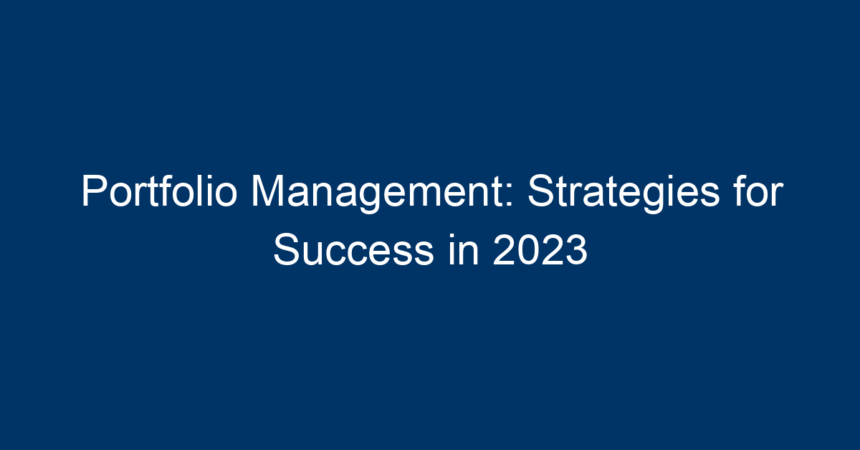In today’s dynamic financial landscape, effective portfolio management has become more crucial than ever. With evolving market conditions, fluctuating interest rates, and a myriad of investment options at your disposal, developing a robust strategy is essential for achieving long-term financial success. This article will explore essential portfolio management strategies tailored for 2023 and beyond, providing actionable insights to enhance your investment approach.
Understanding Portfolio Management
Portfolio management involves the art and science of building and maintaining an investment portfolio in line with an investor’s goals and risk tolerance. This multi-faceted discipline combines various investment strategies to create a diversified portfolio, optimizing returns while managing risk. Let’s delve into the key strategies that could ensure your portfolio thrives in 2023.
Key Portfolio Management Strategies for 2023
1. Diversification: The Cornerstone of Portfolio Management
Why Diversification Matters
Diversification is the practice of spreading investments across various asset classes—such as stocks, bonds, real estate, and commodities—to mitigate risk. By diversifying, you protect your portfolio from significant downturns in any single investment.
Implementing Diversification in 2023
As markets continue to evolve, consider including emerging markets and alternative investments like cryptocurrencies or real estate investment trusts (REITs) in your portfolio. This approach can enhance your risk-adjusted returns, especially during periods of economic uncertainty.
2. Adopting a Growth vs. Value Strategy
Understanding Growth and Value Investing
Growth investing focuses on companies expected to grow at an above-average rate compared to their industry peers, while value investing seeks undervalued stocks that have the potential for price appreciation.
Strategy for 2023
In 2023, striking a balance between growth and value is essential. Market conditions may favor one style over the other. As interest rates fluctuate, consider leaning towards value stocks for stability while selectively investing in growth stocks for potential high returns.
3. Incorporating Technology in Portfolio Management
The Rise of Investment Apps and AI
Technology has transformed portfolio management, with various investment platforms offering algorithm-driven advice. Tools powered by Artificial Intelligence (AI) help in analyzing market trends, asset performance, and investor sentiment.
Utilizing Tech in 2023
Explore robo-advisors that tailor investments according to your financial goals. Additionally, keep an eye on emerging technologies that could disrupt industries, such as fintech solutions that offer lower fees and better accessibility.
4. Risk Assessment: Tailoring Your Portfolio Management Approach
The Importance of Risk Tolerance
Every investor has a unique risk tolerance based on financial goals, time horizon, and personal comfort with market volatility. Assessing your risk capacity is fundamental to effective portfolio management.
Formulating a Risk Strategy for 2023
In 2023, it’s essential to regularly reevaluate your risk profile. Market volatility can influence asset performance, so adjust your portfolio accordingly. If market risks increase, consider reallocating to safer assets to preserve capital.
5. Rebalancing Your Portfolio Regularly
What is Portfolio Rebalancing?
Portfolio rebalancing involves realigning the weights of the assets in your portfolio to maintain your desired level of risk exposure. Over time, certain investments may grow or decline in value, leading to an unbalanced portfolio.
Rebalancing in 2023
Conduct regular reviews—quarterly or biannually—and adjust your asset allocation to reflect market changes and personal circumstances. This practice helps in locking in profits and maintaining your risk profile.
6. Ethical and Sustainable Investment Practices
The Emerging Trend of ESG Investing
Environmental, Social, and Governance (ESG) investing has gained significant traction. Many investors now seek to align their portfolios with their values and invest in companies that are socially responsible.
Incorporating ESG in Portfolio Management
As you strategize your portfolio management in 2023, consider including ESG criteria in your investment decisions. Not only does this allow you to support ethical practices, but many studies suggest that ESG investments can perform as well as or even better than traditional investments over time.
7. Utilizing Tax-Advantaged Accounts
Understanding the Benefits
Managing your portfolio with tax efficiency in mind can significantly impact long-term investment returns. Tax-advantaged accounts, such as IRAs or 401(k) plans, can help you maximize your investment growth.
Strategic Tax Management for 2023
Explore options within Roth IRAs for tax-free growth or traditional IRAs for potential immediate tax reductions. Implement strategies like tax-loss harvesting to offset gains by realizing losses in other investments, thereby minimizing tax liabilities.
Conclusion: Actionable Insights for Your Portfolio Management in 2023
In summary, effective portfolio management in 2023 requires a blend of traditional strategies and innovative approaches. By diversifying your assets, incorporating technology, regularly assessing risk, and considering ethical investments, you can create a resilient portfolio that is well-positioned for success.
Take Action:
- Evaluate Your Current Portfolio: Take stock of your investments, assess performance, and identify areas for improvement.
- Adopt a Balanced Investment Strategy: Consider both growth and value opportunities while monitoring market conditions.
- Integrate Technology: Leverage investment apps and AI tools for insights, analysis, and tracking.
- Reassess Regularly: Schedule periodic reviews to adjust your portfolio to align with your financial goals and market changes.
By implementing these actionable insights, you can enhance your portfolio management strategy and navigate the complexities of the investment landscape in 2023 successfully. Remember, the key to successful investing lies in adaptability and informed decision-making. Stay engaged, informed, and proactive to achieve long-term financial stability.




